Versatile Lemon Syrup (Korean Lemon Chung)
This recipe for lemon syrup (Korean lemon chung) is simple to prepare—all you need is a few ingredients to get started! A versatile recipe, lemon syrup can be used it in hot lemon tea, cold lemonade, or to create savory dishes.

If you love adding a bright, citrusy kick to your drinks or cooking, keeping a jar of Korean lemon syrup (레몬청, lemon cheong) in your kitchen is a game changer. Unlike typical lemon syrup, which you boil down with sugar, you make Korean lemon syrup by layering fresh lemon slices with sugar and letting time create the syrup—no cooking required.
I grew up in Korea where jars of cheong (fruit preserved in sugar) were a common sight on the counter. Lemon cheong, along with plum syrup (maesil-cheong) and yuja (yuzu) syrup, became a household staple for tea, simple home remedies, and quick flavoring in everyday cooking. Even now, I make it the same way—slice, sugar, wait—and end up with a naturally sweet, refreshing lemon syrup that’s vegan, gluten-free, and versatile.
Is lemon syrup traditional in Korean cuisine?
Lemons didn’t grow in Korea, but Koreans rooted the method of making cheong (fruit preserves with sugar) deeply into their food culture. Lemon cheong reflects this tradition, adapting the same preservation technique used for plums, as you see in my green plum syrup (maesil-cheong), or yuja to a fruit that adds a bright, citrusy flavor.
Today, many Korean kitchens make lemon cheong as one of their go-to modern cheong recipes. Home cooks keep it in glass jars and stir it into hot tea in winter, splash it into sparkling water in summer, or whisk it into sauces and marinades year-round.
How to Use Korean Lemon Syrup
This simple syrup isn’t just for drinks—it’s one of the most flexible condiments in Korean home cooking. A few favorite ways to enjoy it:
- Lemonade: Stir into cold still or sparkling water for instant homemade lemonade.
- Lemon tea: Add slices with syrup to hot water for a soothing drink.
- Cold remedy: Steep with ginger (and dried jujube, if you like) in boiling water.
- Simple syrup substitute: Use in cocktails or baking wherever simple syrup is called for.
- Pancake drizzle: Warm and pour over pancakes or waffles in place of maple syrup.
- Salad dressing: Whisk with oil and vinegar for a tangy vinaigrette.
- Savory dishes: Try in crispy lemon chicken or as a marinade for meats that need sweet-tangy flavor.
Notes on Making Homemade Lemon Syrup
- Use the right lemon. When you see the lemons in the market, gently squeeze them to see if they are soft and pliable. If the lemon feels very tight and hard, chances are the white rind part inside the lemon would be thick. You DO NOT want that. Too much rind will make your syrup to be on the bitter side. You want a thin layer of white rind part around the lemon flesh.
- Rub the lemon with baking soda and salt to remove the waxy coating outside.
- Wipe dry the lemon with a clean towel after rinsing.
- Pick out seeds. It is easy to pick out the seeds with your finger after you slice them. Use an equal amount of sugar as to the weight of whole lemon.
- Sterilize your glass canning jars or bottles so that it can prevent any spoilage. After you add the lemon sugar mixture into the jar, turn the jar upside occasionally to evenly distribute the sugar until it dissolves completely.
How to Make Lemon Syrup
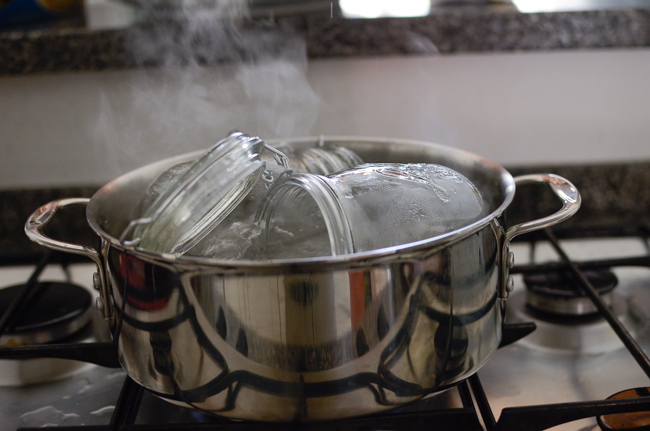
Step 1. Sterilize canning jars in hot water and let them cool and dry.
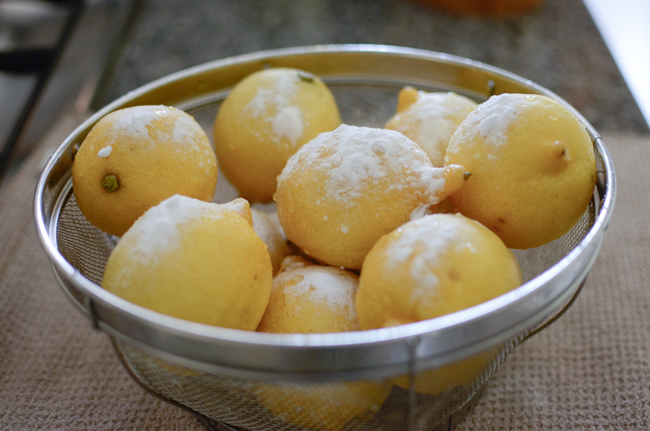
Step 2. Most lemons sold in the markets have waxy coating on the surface. They might have been exposed to the pesticide as well. You will need to remove that. Wash the lemons and scrub them with baking soda. That will remove any chemical residues on the skin.
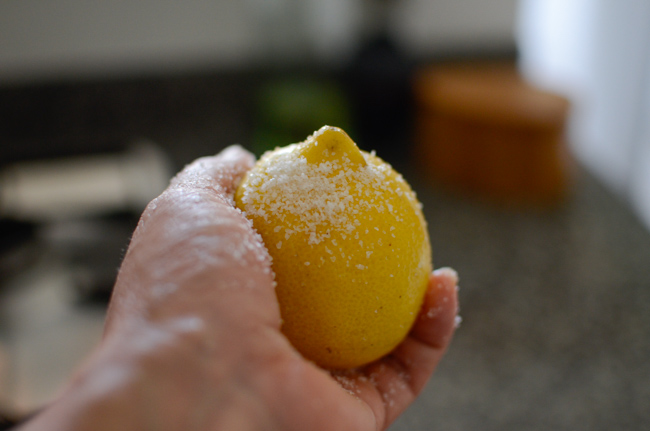
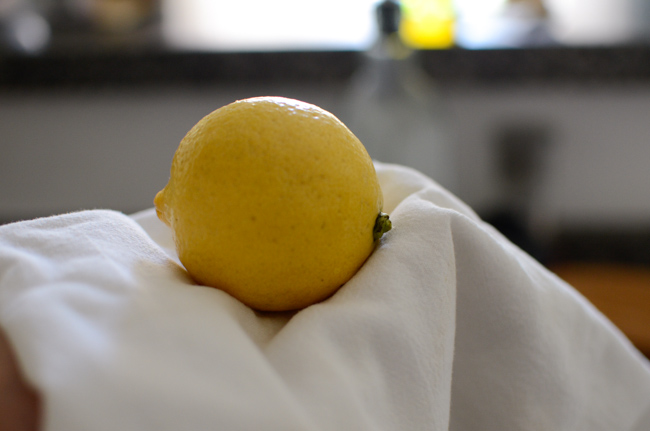
Step 3. scrub them with coarse salt to remove the waxy coating outside. Then rinse and wipe dry with a clean towel.
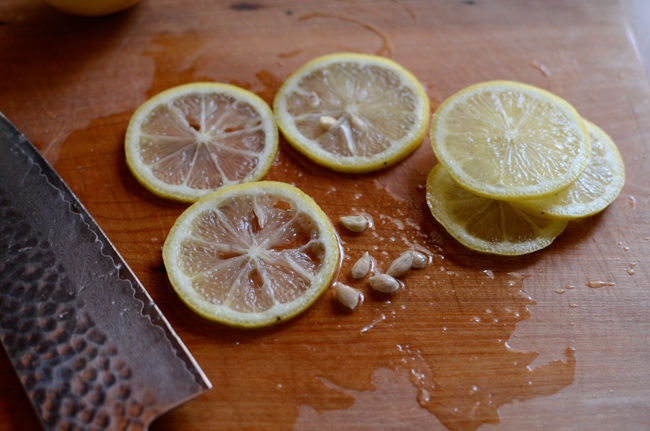
Step 4. You MUST remove the seeds. Lemon seeds cause the syrup with the bitter aftertaste no matter how much sugar you add.
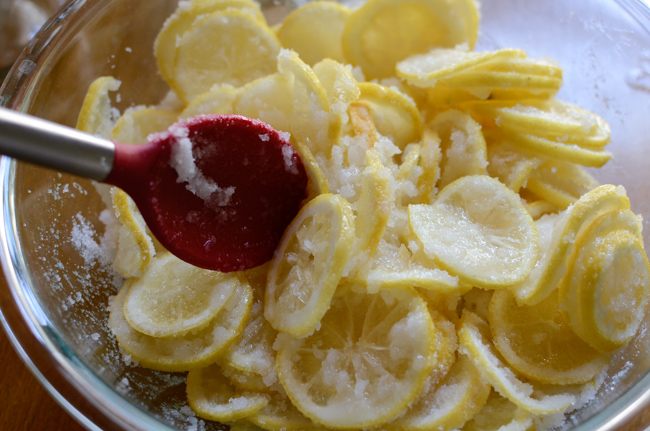
Step 5. Use an equal amount of sugar to the lemon. If you use 2 pounds of lemon, you will need 2 pounds of sugar. 1 : 1 ratio!


Step 6. Mix lemon slices with sugar, and pack them in glass jars. Pour all the remaining sugar syrup, too.
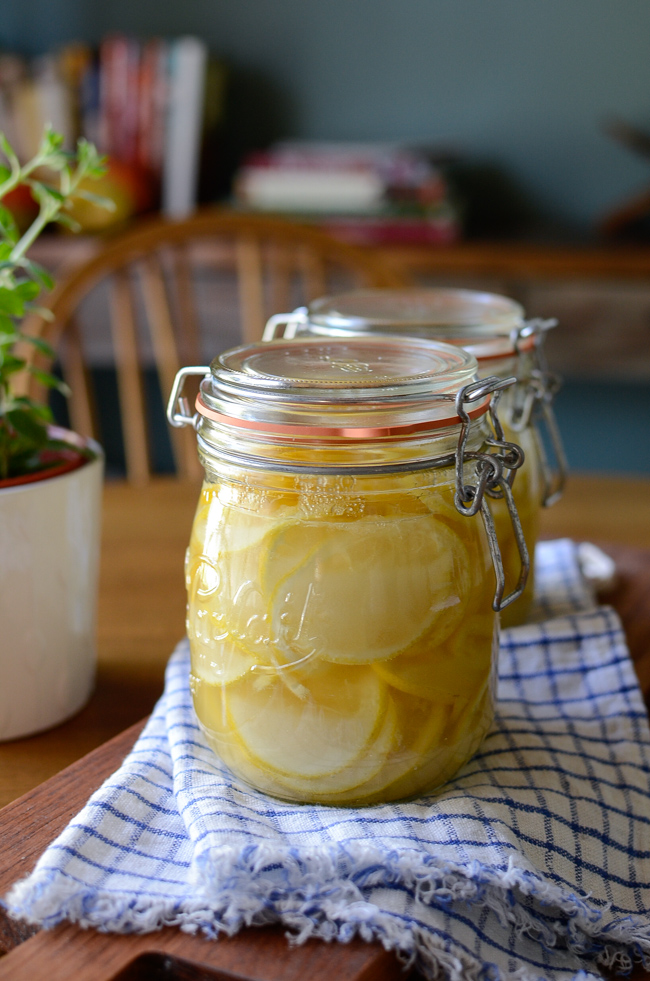
How to Store Lemon Syrup Properly
- Let the lemon syrup sit in a cool room temperature for 3 full days. You will see sugar sitting on the bottom of the jars.
- Turn the jars upside down everyday to evenly distribute the sugar.
- Store them in a cool and dark place for up to one year.
How long does lemon syrup keep for? Unopened jar of lemon syrup will keep fresh up to one year. Once opened, store it in the refrigerator. It will last up to 3 months.
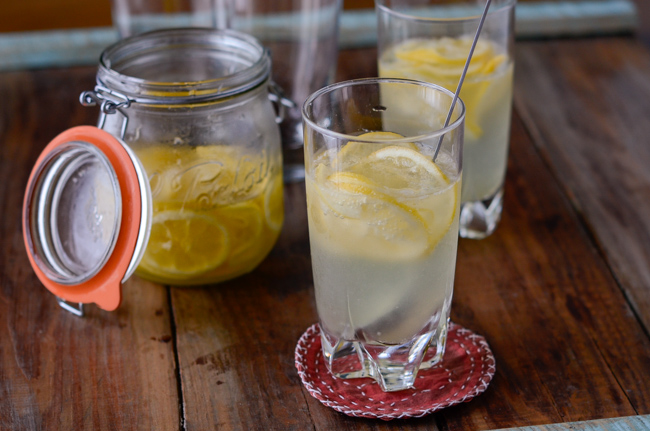
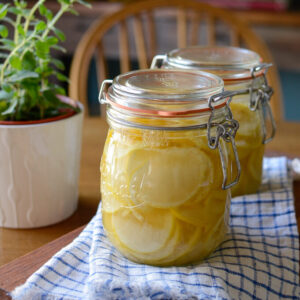
Versatile Lemon Syrup (Korean Lemon Chung)
Ingredients
- 500 g lemon
- 500 g granulated sugar
- baking soda, to clean
- salt, to clean
Equipment
Instructions
- Put the glass jars or bottles in boiling water to sterilize and let them dry completely.
- Wash lemons in cold water. Scrub with baking soda and rinse, then scrub with salt to remove the waxy coating. Rinse well and towel dry completely. Slice the lemons thinly, pick out all the seeds.
- Mix lemon slices with sugar in a large mixing bowl. Pour the lemon and the sugary syrup in the prepared glass jars.
- Store the syrup in a room temperature for 3 days, turning the jars upside down everyday to evenly distribute the sugar. Store them in a dark and cool place. Refrigerate the syrup once the jar is opened.


My wife found some at a local farmers market and enjoyed it so I looked it up and found your recipe. This is perfect and costs so much less. Thanks!
I’m so glad you found it and tried making it yourself! Homemade is definitely more affordable, and I bet your wife loved that fresh flavor even more! Thank you!
Heya! I bought some of this at a farmer’s market this year but the one 16 oz jar cost me $40 CDN. Yikes! I would love to make my own and this recipe will help me do that – question though, how many 16 oz Jars does this recipe make? TIA!
This recipe makes 48 oz (about 6 cups), so 16 oz would be one-third of the total. Thanks!
Hello Holly as I live in Italy I am always on the lookout for something to do with all my fresh lemons. I made this recipe and put into jars but had quite a lot of sugary syrup left in the bowl. My jars are the usual preserve jars and I wondered if this would be a problem . Thanks
You’re supposed to pour all the remaining sugar syrup from the bowl into the jar with the lemon slices. If you’ve already sealed the jar, don’t worry—it should still be fine. Hope you enjoy the lemon syrup!
Hello, I was just wondering if you think this would work the same with a low calorie sugar alternative like stevia, thanks so much!
You can make Korean lemon syrup with Stevia, but it doesn’t have the preserving properties that sugar has. I recommend leaving the jar at room temperature for a few hours and then storing it in the fridge. Also, you will need a smaller amount since Stevia is sweeter than sugar.
Hello,
If I am making a large batch, I want to place them in smaller bottles. Is it okay to open the large batch jar in a month or 3 without messing up the storage process? I would like to keep the small batches in dry storage for a long periods of time.
Sure, you can open the jar after a month. Make sure to store them in the fridge once opened though.
Thanks for the recipe, I’ve made the syrup and it is delicious.
Although after 2 weeks after being made started to ferment and I had to open the jar because all the syrup would just keep spilling out.
The syrup is still nice but is a bit bubbling. Any idea of what could have happened? Can I still use it if I keep it in the fridge?
It is natural to have some bubbles after two weeks due to fermentation, which is an ideal process. Always store the syrup in the fridge, and it will remain safe to eat for an extended period.
Hello! Love the recipe! Is there any way to tell if the cheong is bad? In the jar? How do I know if my cheong has mold or something? I want to make sure it is okay when I am eating it.
Thank you very much for the recipe.
As long as you add the recommended amount of sugar, it won’t become moldy. The only thing you need to be cautious of is that it might ferment and take on an alcoholic odor if left for an extended period (such as over a year).
can i add more honey and new lemon into my old batch?
as the old batch is just so flavourful that it seems a pity to throw it out.
HI i used honey to make mine.
i was wondering if i can just add more honey and lemon slices to the old batch as the old one has kinda aged really well and taste better than the fresh ones.
You can but don’t store it too long with additional honey or sugar. If you keep it too long, the old batch of lemon might get disintegrated and become a little alcoholic.
I am student and living in hostel I want to make lemon syrup .. And I’m concerned about after making does it stay for atleast 1-2 days!! Without being in refrigerator?? as we don’t have refrigerator..
Hi Anjana
You don’t need to refrigerate while it is sealed and dissolving the sugar to turn into syrup. But once opened, you will need to store in the fridge, just like any jam or sweet syrup.
Hope this helps. Thank you.
Can we use honey instead of sugar?
Hi Hovy
Yes, you can use honey instead.
I am SOOO excited I found your recipe today! I plan on making a few jars of your lemon syrup and I want to store them in sterilized jars. I’m concerned because I read that the jars need to be “burped” due to the gas the lemons produce BUT isn’t it true that once the jars are sealed they can NOT be opened until ready to consume and MUST be refrigerated after opening?
Hi Maria
Yes, you will need to refrigerate the syrup once the jar is opened. Unlike making fruit jam, where you will need to put the filled jar back into boiling water so that it seals properly (with the burp sound), this syrup doesn’t need that extra boiling process. So you won’t be hearing the burp sound after the lid is sealed. Keep the syrup in the sealed jar in the pantry avoiding direct sunlight up to 1 year. You can start using the syrup after sugar is completely dissolved (so don’t open the jar until then). Once opened, keep it in the fridge. Hope this helps. Thanks and good luck!
Do you think you could use frozen lemons? I would defrost then slice and remove seeds. I started storing extra lemons this way before I found your recipe.
Hi Carol
You can use frozen lemon to make the syrup. Thanks.
Hi! I really want to make this but I was wonder if instead of leaving it in room temperature for 3 days, can I leave it in the fridge? I live in a rather warm climate and I worry the lemons might go bad.
Thanks!
Hi Rachel
Yes, you can keep the syrup in the fridge from the start but it will take longer to extract lemon juice to turn into syrup. Hope you enjoy the syrup. Thanks.
Do you have to let it sit for three days or can you consume once it is cool?
You will need to let it sit for 3 days or longer so that the sugar can withdraw the juice of the lemon and turn it into syrup.
Are the lemon slices edible, or just the syrup? If so, what would be a good use for them?
Yes, lemon slices are edible and you can add them to any recipes. I explained in my post how to utilize this lemon syrup. You can make lemonade, lemon tea, or any savory dishes that requires lemony sweet taste such as this lemon chicken recipe.
Hi, I’m wondering if I can use brown sugar instead?
I wouldn’t recommend using brown sugar since it will make the syrup very dark and alter the taste.
What would this type of preservation be called? I’ve been looking everywhere trying to find other takes on this like with blueberries or even peppers but all I can find are people preserving things in simple syrup not actually making the syrup using a sugar pack like this. You wouldn’t happen to know what this method is called.
Hi David
We call the preservation “Cheong” in Korean. It is simply sugaring the fruits extracting their natural water content and preserving them in their own syrup for a long period of time. I am not sure what would be the proper English name. Perhaps, sugaring?
I made lemonade but it’s tastes bitter…..should I put salt or more sugar to get rid of bitter taste 🤔
Did you lemon have an extra thick layer of white rind around the lemon flesh? Sometimes the type of lemon with the extra thick white rind cause the bitter taste. You can add more sugar to counter balance the bitter taste, but as the time goes and the bitterness will subside. Hope this helps.
Hi my lemon syrup has an aftertaste. Please help i don’t want to throw it away.
What is the aftertaste like? Is it bitter?
Yes. Can you help me please. I tried it before and it didn’t taste like this.
I hope you have removed the seeds from the lemon. Seeds cause the bitter taste.
Also the quality of lemon makes different outcome as well.
The only way to save the bitter syrup is to let it sit longer in the sugar. The longer you keep, the less bitter taste you get. Try waiting for at least one month (in the fridge) and see if the bitterness has lessened. If you need it sooner, then add more sugar to the syrup.
Hope this helps
Hi, What ratio of concentrate to water do you normally use when making lemon tea with this syrup? I know it depends on personal taste too, but for example, 2 tablespoons for 1 cup of tea?
Many thanks, Natasha
Hi Natasha
For 1 cup of tea, I would use 2 tbsp of this syrup. You can always add more if you like more intense lemon flavor.
Thanks.
Heya I tried this yesterday morning and now some of the lemon slices are already brown, does this mean it’s not edible / safe for consumption?
If the lemon slices turned brown, then the lemon slices have been exposed to air. Did you use an airtight container? Make sure to turn the jar upside down often so the sugar syrup will cover the lemon evenly. It should be okay to consume the browned lemon. But once you open, keep it in the fridge, and try to finish within a few weeks.
Wonderful recipe! Can I use erythritol instead of sugar? I have a sugar intolerance
I think you can. Make sure to keep the lemon syrup in the refrigerator once opened.
Thank you!
Hi! I’ve made this just today, with lemon and ginger, and was wondering if I could add some dried lavender to one of the batches for a change in flavour.
Can’t seem to find any info about it anywhere!
Also, I noticed the sugar pools at the bottom, is that okay? Should I have stirred it further before putting it away?
Hi Kay
You can add lavender to the batches. It will infuse nicely.
You will need to turn the jars upside down everyday to evenly distribute the sugar for a few days. Do not open any jar if you want to keep it for a longer storage. You can stir the syrup once you open it and make sure to keep the opened jar in the refrigerator.
Hope this helps.
Can I use allulose instead of sugar
I have not tried this syrup with allulose, so I can’t guarantee. But I think it will work. I would try with a small batch first, though, just to make sure.
Hi, if the lemon slices go mushy, does it mean it’s spoilt?
No, they will turn mushy as they will melt in sugar.
Hi, I’m wondering if I can use brown sugar instead? And add ginger slices in with the lemons?
I just made this and it has been sitting in my pantry for 3 days now. I didn’t seal the jars, but I did sterilize them, does it matter that I didn’t make the seal? I am so worried my creation is going to rot!
And by seal I mean in the canning sense. I did put a lid on it tight and it is in canning jars. Also, there is some air in the jar, is that going to impact it?
This looks great! So it lasts in pantry for one year, and then once opened it can last in fridge for one year?
Yes. once you open it make sure you keep it in the fridge.
thank you for sharing. this is what i looking for ^.^
can i add honey/gingger in it or just add when i make some
Yes, you can add honey /ginger when you make the drink. Thanks.
Can I use honey instead of sugar?
Hi Amber, I wouldn’t recommend honey.
Can I use lime instead of lemon to make this syrup? Do you think that lime or lemon will leave a bitter aftertaste as the lemon zest or lime zest contains oil?
Hi Andy
You can use lime instead of lemon. Since it has a plenty of sugar, the zest won’t leave any bitter taste. Just make sure to remove all the seeds before you add sugar.
How long does it keep once open in the fridge?
It can last up to a year.
Yesterday I was lucky and found some organic lemons that specifically have an eatabile peel. And, second time lucky, only one out of seven had seeds. So it was great and quick fun to make this syrup. I’m looking forward to try it out once the next heatwave hits.
Thank you! <3
Great to hear that! Hope it turns out great!
This really does look like sunshine in a jar! What a fun way of making lemon syrup! So good!
Wow, this looks absolutely divine! My mouth is watering thinking of all the things I could make with this lemon syrup!
LOVE lemon! In fact you might say I’m a lemon freak. Just can’t get enough. Never had a syrup like this — so you know I gotta try it! Really good — thanks.
I know, I do love lemon and can’t get enough of it. This is very handy syrup to keep in the kitchen for various uses.